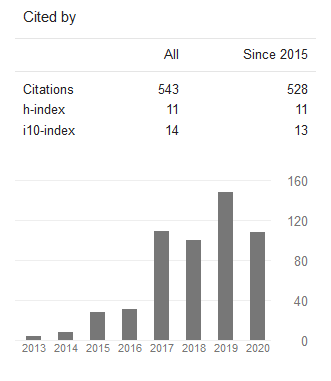Pembangunan Aplikasi Klasifikasi Mahasiswa Baru untuk Prediksi Hasil Studi Menggunakan Naïve Bayes Classifier
DOI:
https://doi.org/10.24002/jbi.v7i2.492Abstract
Abstract. Every university hopes to create the best potential graduates. Some of the efforts can be achieved by utilizing university data to be processed into information. The resulting information can help the university to determine the decisions to take in improving the students’ academic performance. One of the methods to process the data is by using Naive Bayes Classifier. This method requires some information such as GPA, average credits and attendance percentage. The prediction results are taken based on the data of the students at the university. Because there are large number of data to process it will require an information system that can classify data using Naïve Bayes Classifier. This application is built by using C# programming language with an average of 81,67% accuracy results (the accuracy depends on the data used). This application is expected to help the university to increase the achievements of its graduates.
Keywords: Classification, Naive Bayes, Machine learning, Data mining
Abstrak. Setiap universitas tentu berharap dapat meluluskan mahasiswa dengan prestasi terbaik. Usaha meningkatkan prestasi dapat diwujudkan dengan memanfaatkan data universitas untuk diolah menjadi informasi. Informasi yang dihasilkan dapat berguna untuk menentukan keputusan yang harus diambil pihak universitas dalam meningkatkan prestasi. Salah satu metode yang digunakan untuk memproses data ialah metode klasifikasi Naive Bayes. Metode ini menggunakan beberapa informasi seperti IPK, rata-rata sks dan persentase kehadiran mahasiswa sebagai data pelatihan. Data pelatihan tersebut digunakan untuk memprediksi IPK, rata-rata sks dan presentase kehadiran mahasiswa baru sebagai data uji. Adanya data yang cukup besar untuk diolah, maka dibutuhkan aplikasi klasifikasi mahasiswa baru menggunakan metode Naive Bayes Classifier. Aplikasi ini dibangun menggunakan bahasa pemrograman C# dengan rata-rata hasil akurasi 81,67%. Aplikasi ini diharapkan dapat membantu universitas dalam meningkatkan hasil prestasi akademik mahasiswa.
Kata Kunci: Naive Bayes, Pembelajaran mesin, Penambangan data
References
. Abdul Aziz, Azwa, Ismail, Nur Hafieza, & Ahmad, F. 2013. Mining Students’ Academic Performance. Journal of Theoretical and Applied Information Technology, 53(3):485.
. AI-Radaideh, Q.A., AI-Shawakfa, E.M. & AI-Najjar, M.L. 2006, December.Mining Student Data using Decision Trees.In International Arab Conference on Information Technology (ACIT’2006), Yarmouk University, Jordan, November.
. Alcala, J., Fernandez, A., Luengo, J., Derrac, J., Gracia, S., Sanchez, L. & Herrera, F. 2010. Keel Data-Mining Software Tool: Data Set Repository, Integration of Algorithms and Experimental Analysis Framework. Journal of Multiple-Valued Logic and Soft Computing, 17:255-287.
. Ardianto, T. 2010. Perbandingan Decision Tree C4.5 dan Naïve Bayes dalam Implementasi Klasifikasi Konsumen Asuransi Kesehatan. Skripsi.Universitas Pendidikan Indonesia. Bandung.
. Baradwaj, B.K. & Pal, S. 2011a.Mining Educational Data to Analyze Students’ Performance. International Journal of Advanced Computer Science and Applications, 2(6): 63-69.
. Baradwaj, B.K. & Pal, S. 2011b. Data Mining: A Prediction for Perfomance Improvement using Classification. International Journal of Computer Science and Information Security, 9(4): 136-140.
. Han, J. & Kamber, M. 2006. Data mining: Concepts and Techniques, Morgan Kaufmann Publishers Inc, San Francisco, CA, USA, 2nd edition.
. Hastuti, K. 2012. Analisis Komparasi Algoritma Klasifikasi Data Mining untuk Prediksi Mahasiswa Non Aktif. Seminar Nasional Teknologi Informasi & Komunikasi Terapan, Semarang, 23 Juni.
. Jananto, A. 2013. Algoritma Naïve Bayes untuk Mencari Perkiraan Waktu Studi Mahasiswa.Jurnal Teknologi Informasi DINAMIK, 18 (1): 9-16.
. Kotsiantis, S., Pierrakeas, C. & Pintelas, P. 2004. Predicting Students’ Performance in Distance Learning Using Machine Learning Techniques. Applied Artificial Intelligence: An Internation Journal, 18(5): 411-426.
. Pandey, U.K. & Pal, S. 2011. Data Mining: A Prediction of Performer or Underperformer using Classificaion. International Journal of Computer Science and Information Technology(IJCSIT), 2(2): 686-690.
. Romero, C. & Ventura, S. 2007. Educational Data Mining: A Survey from 1995 to 2005. Expert Systems with Apllicaions, 33(1):135-146.
. Shadiq, M.A. 2009. Keoptimalan Naïve Bayes Dalam Klasifikasi, Program Ilmu Komputer FPMIPA Universitas Pendidikan Indonesia.
. Ting, S.L., Ip, W.H., & Tsang, A.H.C. 2011. Is Naïve Bayes a Good Classifier for Document Classification? International Journal of Software Engineering and Its Applications, 5 (3):37-46.
. Trisedya, B.D. , & Jaiz, Hardinal.2009. Klasifikasi Dokumen Menggunakan Algoritma Naïve Bayes dengan Penambahan Parameter Probabilitas Parent Category, Fakultas Ilmu Komputer Universitas Indonesia.
Downloads
Published
Issue
Section
License
Copyright of this journal is assigned to Jurnal Buana Informatika as the journal publisher by the knowledge of author, whilst the moral right of the publication belongs to author. Every printed and electronic publications are open access for educational purposes, research, and library. The editorial board is not responsible for copyright violation to the other than them aims mentioned before. The reproduction of any part of this journal (printed or online) will be allowed only with a written permission from Jurnal Buana Informatika.
This work is licensed under a Creative Commons Attribution-ShareAlike 4.0 International License.









